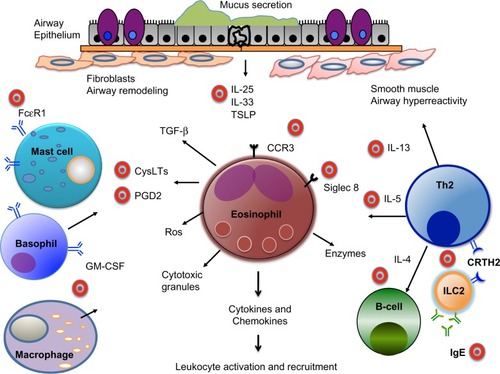Figures & data
Figure 1 Schematic of eosinophils in airway inflammation and therapeutic targets. In response to allergens, viruses, or mucosal injury, airway epithelial cells produce cytokines, including IL-25, IL-33, and TSLP, which promote differentiation of Th2 cells, as well as activation of mast cells, macrophages, and type 2 innate lymphoid cells. IL-4 and IL-13 produced by Th2 and other cells results in eotaxin production, B-cell IgE class switching, airway hyperresponsiveness, and mucus secretion. IL-5 stimulates bone marrow eosinophil generation, and mediates recruitment, activation, and survival of eosinophils. GM-CSF produced by alveolar macrophages and eosinophils contributes to maturation and survival of eosinophils. Eosinophils release major basic protein, ROS, and enzymes, as well as Th2 cytokines and inflammatory lipid mediators including cysteinyl leukotrienes and prostaglandin D2. These products result in recruitment and activation of immune and structural cells. Further, production of Th2 cytokines and growth factors, such as TGF-β, contribute to features of airway remodeling in chronic asthma. A number of therapeutic targets (depicted by bullseyes) have been identified for eosinophilic asthma and are currently under investigation.

